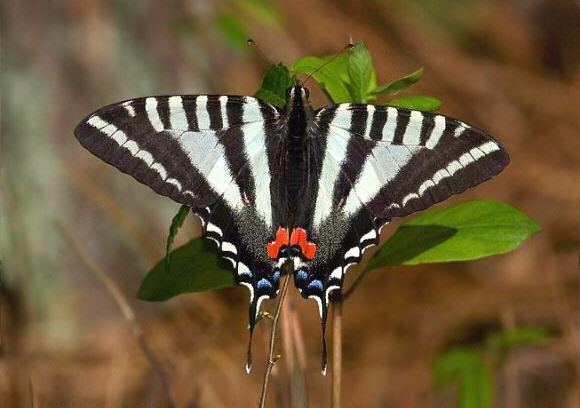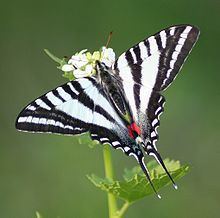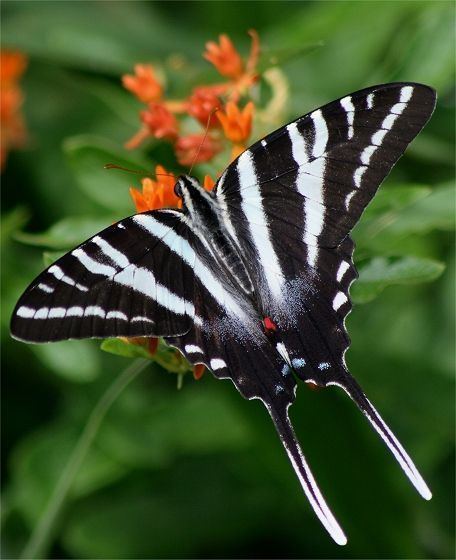Family Papilionidae | Rank Species | |
 | ||
Similar Eurytides, Papilio troilus, Eastern tiger swallowtail, Black swallowtail, Battus philenor | ||
Protographium marcellus
Protographium marcellus, the zebra swallowtail, (formerly listed under genera Eurytides, Iphiclides, Graphium and Papilio by some authorities) is a swallowtail butterfly native to the eastern United States and southeast Canada. Its distinctive wing shape and long tails make it easy to identify, and its black-and-white-striped pattern is reminiscent of a zebra. The butterflies are closely associated with pawpaws, and are rarely found far from these trees. The green or black caterpillars feed on the leaves of various pawpaw species, while the adults feed on flower nectar and minerals from damp soil.
Contents

Description

The zebra swallowtail has a wingspan of 6.4 to 10.4 cm (2.5 to 4.1 in). The triangular wings are white to greenish white with black longitudinal stripes. A pair of swordlike tails extend from the hindwings. The inner margin of the hindwing has two blue spots on the corner and a red spot near the body. A red stripe runs along the middle of the ventral hindwing. P. marcellus has two seasonal forms, one occurring in the spring and the other in the summer. Spring forms are smaller, more white, and have short, black tails with white tips. Summer forms are larger, have broader black stripes, and longer, black tails with white edges.
Flight period

The zebra swallowtail can be seen from late March to August in the northern portion of its range and from February to December in the southern portion. It has two broods in the north and three to four in the south, with the first brood being the most numerous.
Behavior

Males will patrol near host plants in search of females, flying swiftly and directly. They usually fly 0.5 to 1.8 meters (2 to 6 ft) above the ground. Females will fly slowly when searching for suitable host plants. Both males and females avidly visit flowers, including species from the families Apocynaceae, Brassicaceae, Fabaceae, Lythraceae, Polemoniaceae, and Rosaceae. Males participate in a behavior known as puddling, in which individuals congregate on sand, gravel, or moist soil to obtain salts and amino acids. These nutrients aid the male in reproduction. Other food sources include rotting fruit and urine.
Life cycle
Since the caterpillars are cannibalistic, females lay their eggs singly on pawpaw leaves or on the tree trunks. The round egg is pale green, later turning orange brown. Young caterpillars are black with lighter colored transverse stripes. Older larvae have two color forms. The more common form is green with yellow and white transverse stripes; the rarer form is black and banded with white and orange. In both forms, between the swollen thorax and the abdomen, there is a yellow, black, and bluish-white band. The larva has a yellow, foul-smelling, forked gland called an osmeterium which it will use to deter predators, especially spiders and ants. The chrysalis is either green or brown, and is more compact compared to chrysalids in the genus Papilio. Three small horns project from the head and thorax. The chrysalis hibernates in areas of its range with cold winters.
Host plants
The zebra swallowtail caterpillar feeds only on species within the genus Asimina. Commonly used species include A. angustifolia (slimleaf pawpaw), A. incana (woolly pawpaw), A. parviflora (smallflower pawpaw), A. reticulata (netted pawpaw), A. tetramera (four-petal pawpaw), and A. triloba (common pawpaw). P. marcellus caterpillars ingest chemicals called annonaceous acetogenins from their host plants, which are retained in the body tissues of both the caterpillar and the adult, and may help chemically protect the butterfly from birds.
